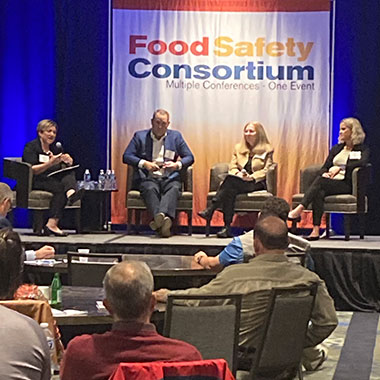Communicating to the C-Suite

Food safety and quality assurance leaders are competing for a finite number of dollars within their respective organizations. Securing support or funding for new equipment, training or personnel can be challenging. Understanding the competing pressures and needs of corporate leaders can help FSQA professionals get their message across and ensure a commitment to food safety.
At the 2022 Food Safety Consortium in October, Deb Coviello, CEO, founder and business advisor at The Drop In CEO, moderated a panel discussion “Communicating to the C-Suite.” Panelists Peter Begg, senior vice president of quality and food safety at Hearthside Food Solutions, Melanie Neumann, JD, executive vice president and general counsel of Matrix Sciences International, and Ann Marie McNamara, vice president of food safety and quality for supply chain, manufacturing and commercialization at U.S. Foods, shared their tips and best practices for getting your message across in the board room.
When approaching the C-suite with updates and asks for financial support, you want to be both confident and concise. “If you can’t explain in five to seven slides what you need and why, you will lose them,” said Begg. “And it is very likely that you yourself do not understand the issue or are unclear of the implications and what the C-suite needs to know.”
Subscribe to the Food Safety Tech weekly newsletter to stay up-to-date on upcoming events and the latest news and information on food safety.
McNamara tries to keep it to one slide and encourages FSQA professionals to: know your audience, stick to the facts, and communicate like an executive by using their terms and focusing on goals and metrics.
“You have to take off your FSQA hat and put on your business hat,” she said. “You can’t just be a technical expert, you need to be a translator and communicate the technical into business terms.”
Equate Risk to Dollar Amounts
If your consumers are at risk due to poor training, difficult-to-clean equipment or other concerns, you need to quickly equate the risk to a dollar amount when communicating with the C-suite. “You can use baseline data to quantify your risks,” said Neumann. For example, if you have a problematic piece equipment, look at the frequency and likelihood of inspection and the potential findings, and share this information as part of your presentation.
She follows a “go back to kindergarten” strategy to help develop a compelling presentation: learn and share the basic math, follow your ABCs by using clear, concise language and “do some show and tell,” said Neumann. In one instance, she brought a joint with multiple weld points from the floor to the board room to illustrate why this particular piece of equipment was so difficult to sanitize and had become a site of contamination. The leadership agreed to replace it.
“You need to be specific, and pick your battles,” said Neumann. “For example, if you need more ‘help,’ what does that look like—do you need more people, more training, a new system?”
Building Your Confidence
Standing in front of a group of executives to fight for your department can be intimidating. If public speaking is not your forte, practice speaking in front of a group. “Share your presentation with your team and ask what questions they would have to get feedback and input,” said McNamara.
Doing regular check-ins with the CFO regarding future resource needs, rather than waiting for a quarterly or annual presentation opportunity, can help you get a headstart on coming asks. In fact, developing relationships with all C-suite leaders is key to keeping food safety needs top of mind. “Introduce yourself to new leaders and understand how they want to be communicated with (i.e., text, email, phone),” said Begg. “Do regular check-ins with leadership and recommend quarterly presentations to keep them up to date.”
While all three panelists encouraged FSQA professionals to avoid getting emotional and focus on the facts as well as dollars and cents, you do want to remind executives of the impact of failure to act on food safety concerns. “Explain the financial risks and speak in terms of the impact to them, ‘What we want everyone in the company to understand is your loved ones are eating this food,’” said Begg.